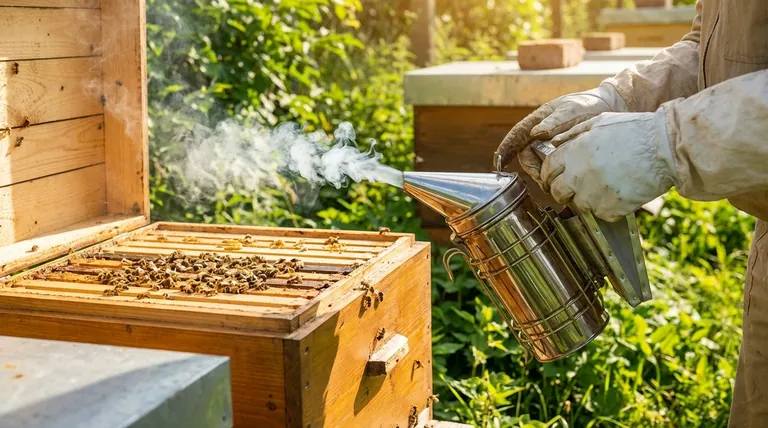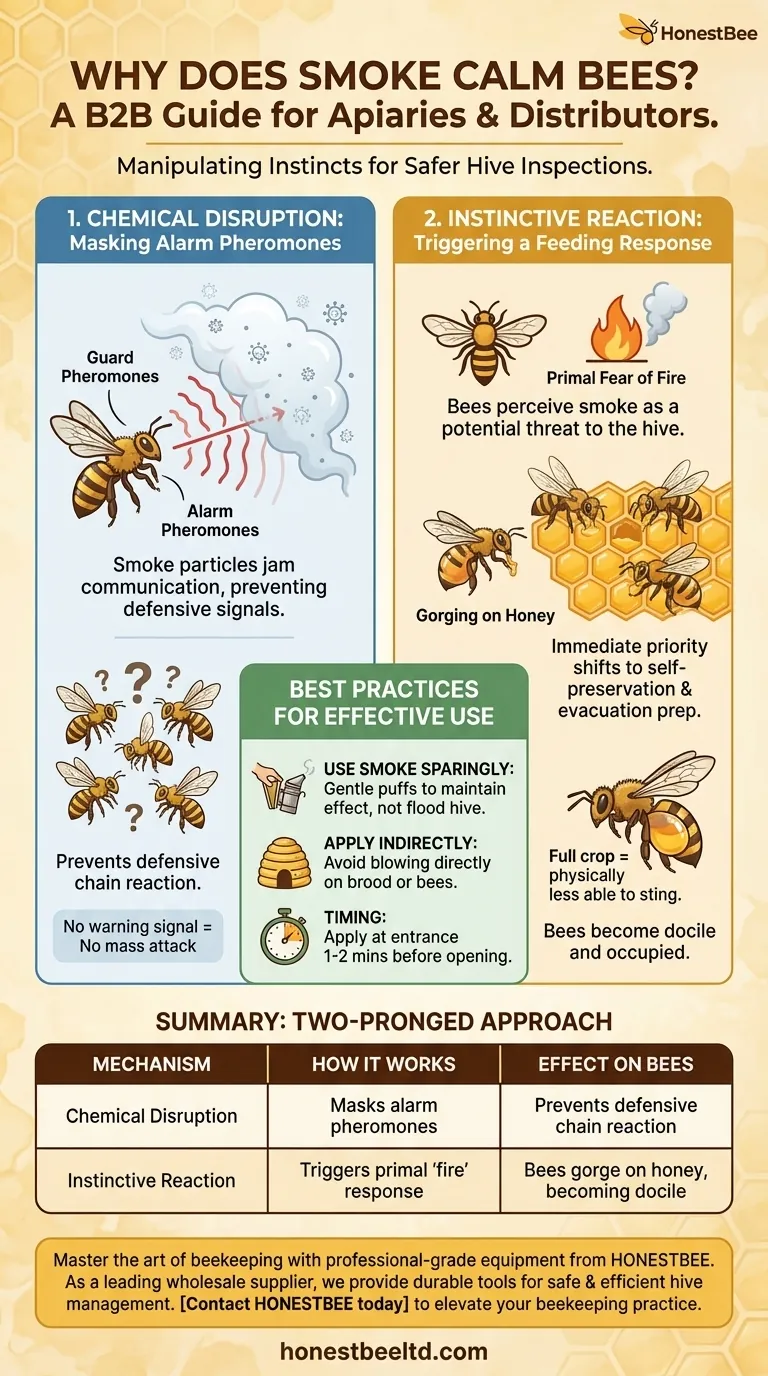At its core, smoke calms bees by manipulating their two most powerful instincts: communication and survival. The smoke interrupts their ability to send chemical alarm signals throughout the colony and simultaneously triggers a primal response to a potential hive-destroying fire, causing them to focus on eating honey rather than defending the hive.
The effectiveness of smoke is a two-pronged approach. It first scrambles the bees' defensive communication network and then redirects their collective energy from defense to self-preservation, making the colony far more docile.

The Chemical Disruption: Masking Alarm Pheromones
What are Alarm Pheromones?
When a guard bee perceives a threat or is injured, it releases alarm pheromones. These are airborne chemical signals that essentially scream "danger" to the rest of the colony.
Other bees detect these pheromones with their antennae, which triggers an immediate and widespread defensive response. This is how a single disturbed bee can quickly incite thousands of others to attack.
How Smoke Interferes
The particles in cool, white smoke effectively jam this communication system. The smoke masks the alarm pheromones, preventing other bees from detecting the warning signal.
Without this chemical trigger, the defensive chain reaction never starts. The alarm is contained to only the few bees that are directly disturbed, rather than escalating into a full-blown colony defense.
The Instinctive Reaction: Triggering a Feeding Response
A Primal Fear of Fire
Smoke is a universal sign of fire, which is a catastrophic threat to a bee colony living in a tree or wooden hive. Bees have an ancient, hardwired instinct to respond to this specific threat.
The "Evacuation" Instinct
When bees detect smoke, their instinct tells them the hive may be destroyed and they might need to abandon it. Their immediate priority shifts from defending their home to preparing to leave it.
Gorging on Honey
In preparation for a potential evacuation, bees will rush to open honey cells and begin gorging themselves. They fill their honey stomach, or crop, with as much honey as they can carry.
A bee with a full stomach is physically less able to flex its abdomen to sting. This combination of being distracted by eating and physically encumbered makes them significantly more placid and manageable.
Understanding the Trade-offs and Best Practices
The Goal is Calm, Not Chaos
The objective is to use just enough smoke to trigger these responses without harming or overly agitating the bees. Too much smoke, or smoke that is too hot, can be counterproductive and stressful for the colony.
Use Smoke Sparingly
A few gentle puffs at the hive entrance before opening it, followed by occasional puffs across the top of the frames, is usually sufficient. You want to maintain the effect, not flood the hive.
Apply Smoke Indirectly
Avoid blowing smoke directly onto the bees, especially on the brood. This can cause unnecessary agitation. The goal is to allow the smoke to drift gently through the hive, not to blast the bees with it.
How to Apply This Knowledge Effectively
By understanding why smoke works, you can use it more intelligently during inspections.
- If your primary focus is preventing a defensive chain reaction: Use a few puffs of smoke at the entrance 1-2 minutes before opening the hive to mask any initial alarm pheromones from the guard bees.
- If your primary focus is keeping bees occupied during an inspection: Apply gentle puffs across the top bars to encourage the bees to move down and begin feeding, clearing your workspace.
Ultimately, using a smoker is about working with the bees' natural instincts, not against them.
Summary Table:
| Mechanism | How It Works | Effect on Bees |
|---|---|---|
| Chemical Disruption | Smoke particles mask alarm pheromones. | Prevents defensive chain reaction. |
| Instinctive Reaction | Triggers a primal 'fire' response. | Bees gorge on honey, becoming docile. |
Master the art of beekeeping with professional-grade equipment from HONESTBEE.
As a leading wholesale supplier to commercial apiaries and distributors, we provide the durable, reliable tools you need for efficient and safe hive management. Let our expertise and high-quality supplies help you run a more productive and profitable operation.
Contact HONESTBEE today to discuss your wholesale needs and elevate your beekeeping practice.
Visual Guide

Related Products
- European Stainless Steel Bee Smoker for Honey Bee Hive
- Stainless Steel Honey Bee Smoker Hive and Honeycomb Smoker for Beekeeping
- Economy Galvanized Beekeeping Honey Bee Smoker for Wholesale
- Premium Traditional Copper Bee Smoker with Bellows
- 54-Piece Smoker Fuel Pellets for Beekeeping Beehive Smoker Fuel
People Also Ask
- What factors should be considered when choosing a bee smoker? Find the Right Tool for Safe, Effective Hive Management
- What are the differences between stainless steel and galvanized steel bee smokers? Choose the Right Smoker for Your Apiary
- What are the key benefits of using a bee smoker? Master Hive Inspections Safely and Efficiently
- What are the steps to operate a bee smoker? Master the Art of Gentle Beehive Management
- What are the features of a recommended bee smoker? A Guide to Safety, Durability & Performance



















